Let’s pick a 1990s England XI. We’re not looking for a good team here; we’re not trying to pick a bad one either. We’re just trying to pick an England Test team that couldn’t be more Nineties if it tried.
A 1990s England team is not really about the stalwarts for the simple reason that picking players repeatedly is very much not what the Nineties was about for England.
The Nineties was about failing to ever establish a settled XI. So, as paradoxical as it is, we have to try and reflect that in our team.
There are exceptions.
Firstly, Mike Atherton made his Test debut in 1989 and retired in 2001. He was a central figure throughout the Nineties. He has to play.
Similarly, Alec Stewart played from 1990 to 2003. Sometimes he was an opener, sometimes he was a wicketkeeper and from time to time he was captain. (Even some of the Nineties regulars didn’t have settled roles.) Stewart has to play too.
Graeme Hick and Mark Ramprakash are as 1990s England as it’s possible to be. Brilliant, rubbish, dropped and recalled. They have to be in the side, if only so that we can drop them for the next game.
Beyond that, you’re spoilt for choice – particularly when it comes to seam bowlers who earned fewer than 10 caps. We reckon there were 14 of them.
Here’s the list.
- Neil Williams
- Steve Watkin
- Tim Munton
- Neil Mallender
- Paul Taylor
- Mark Ilott
- Martin McCague
- Martin Bicknell
- Joey Benjamin
- Peter Martin
- Simon Brown
- Chris Silverwood
- Mike Smith
- Ed Giddins
But we’re not picking any of these guys because there were seam bowlers who played slightly more often who we’re sure you’ll agree feel far more redolent of the age.
We’ll come back to that in a minute though. For now we’ve got some holes to fill further up the order.
Working on the assumption that Mark Lathwell doesn’t want to play, we’ve gone for Nick Knight as Atherton’s opening partner.
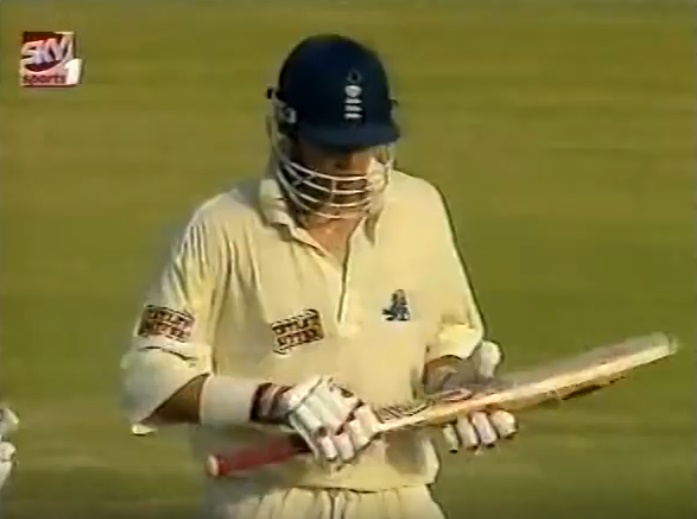
Knight’s case is a sly but strong one. We saw him loads during the 1990s because he played 100 one-day internationals – but cannily, he only played a handful of Tests. As we’ve already established, playing a handful of Tests is actually way more 1990s than playing a great many Tests.
At number five, we’ve picked Aftab Habib, who has always seemed the archetypal, ‘oh, I didn’t expect that,’ middle-order selection and you need at least one, ‘oh, I didn’t expect that,’ selection.
After Stewie, we’ve indulged in a couple of classic all-rounders: Mark Ealham and Ronnie Irani. We think it’s important to try and strengthen the batting, fail to do so, and succeed only in weakening the bowling.
We were keen to balance our attack with a left-armer – which just had to be Alan Mullally – and although you could argue we really should stick to fast-medium, we also wanted a fast bowler. We’ve gone for Devon Malcolm, largely on the strength of his batting.
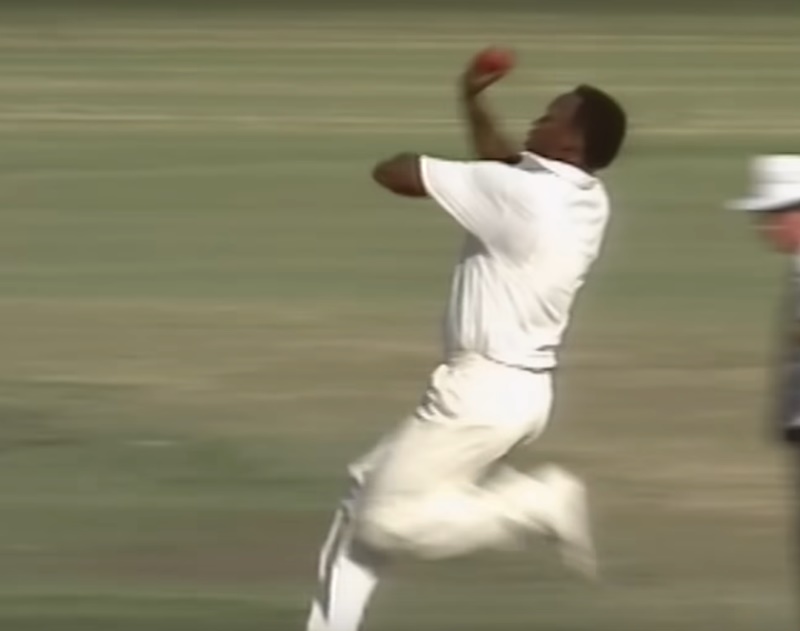
We initially included Ian Salisbury in our team on the basis that it would have proven controversial, which is exactly what the inclusion of Salisbury always was. However, in the end we reversed our decision because the lure of Phil Tufnell was simply too great.
Tuffers’ inclusion means our XI has both an ostensibly long batting line-up and also a comically long tail. Plus you get his fielding.
Our 1990s-est England XI
- Athers
- Nick Knight
- Hick
- Ramps
- Habib
- Stewart
- Ealham
- Irani
- Mullally
- Malcolm
- Tufnell
Now that we’ve got a Nineties England XI and a Nineties Australia XI, there is of course only one possible course of action. We pit them against each other in a one-off exhibition Test – Sim Nineties: the 1990s-est Ashes.
Then we pit them against each other in a rematch Down Under.
Further reading: The Awkwardest Squad: Why the 96/97 “flippin’ murdered ’em” tour of Zimbabwe was peak 90s England (a net bowler’s story)
Thanks to everybody who’s currently funding King Cricket on Patreon. Your pledges help us do features like this. If you’re not currently a King Cricket patron and you’d like to see us to do more with the site, you can flip us a shiny coin or buy us a pint each month here. Don’t feel you have to, but huge thanks if you do.

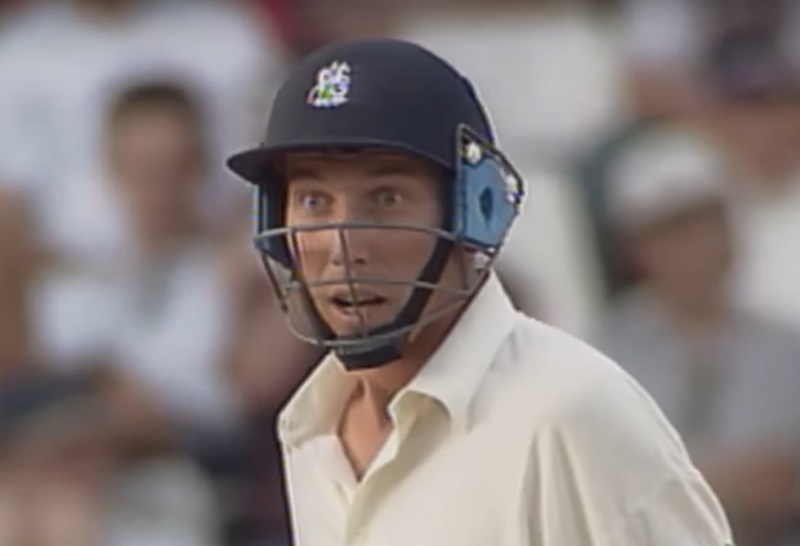
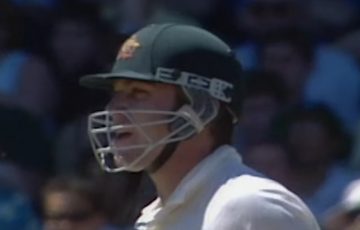
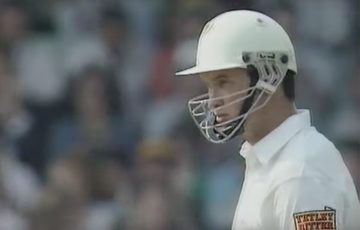
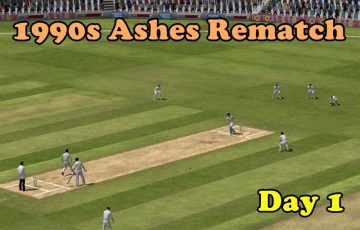
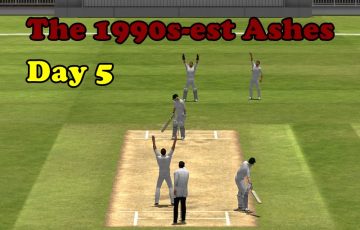
Brilliant. And almost correct as well. There is just one small (*) error.
Darren Gough
Darren Gough was English bowling in the 90s, because he was uniquely good enough. Watching him carrying the entire attack on his (admittedly broad) shoulders was one of the 90s great frustrations. “If only he had some support,” we’d cry. “We’re only one decent bowler away from being a great team,” we would opine.
He also got a “new Botham” tag from the press, because he could occasionally (twice) go past 50. New Botham in every other regard, only his batting (average 12) stopped him from being one of the great all-rounders.
So I won’t accept a 90s test team without him, even if everyone else is absolutely correct. Swap one of Ealham / Irani for him and watch as the Britpop comes roaring back.
(*) Massive, huge, gaping
As ever, on point there Bert.
When did Mark Butcher play? I loved his bowling.
I know he’s not random enough a selection for this team.
Butcher 1997-2004, so not quite the right span.
We largely agree with you, Bert.
It was tricky to weigh the 90s stalwarts against the typically 90s cameo players. Gough could come in for Malcolm, or, as you say, he could turf out Ealham or Irani.
That said, it might surprise you to learn that Gough played 24 of his 58 Tests in the 2000s.
Most people’s idea of a typical 1990s Test team is one from 1999. It’s odd to think recency bias could skew things at such a remove, but we think it still does.
Was Gooch in the running for a 90s team? He was good for a third of them wasn’t he? Or maybe he wasn’t. I was a child. And too lazy to look things up as an adult.
He could come in for whichever one of Hick and Ramprakash was currently dropped.
But it’s your team. And a fine one! So I’ll pipe down.
The fact that you’re not sure is an answer in itself.
If you want the facts, he played 45 of his 118 Tests in the 1990s.
Absolutely loving this, KC.
Will this team play a Sim Series of any kind? I do hope so.
I saw very little live cricket in the 1990s. Not much on the TV either, as I had no TV at my flat between June 1990 and December 1999. I did catch the odd glimpse at Daisy’s place on the TV.
But I did go to Lord’s – my first ever visit there, in 1996. Here is my report on that day:
http://ianlouisharris.com/1996/07/26/my-first-visit-to-lords-england-v-pakistan-day-two-26-july-1996/
A quintessentially 1990s team, that, with a fair few from your chosen XI.
Hard to answer that question without spoilers.
Hard to ask a penetrating “why won’t you answer the question?” question without coming across as a bell end and without actively seeking spoilers…
…so I won’t do that.
That’s an excellent 90s team. Proper mid-90s too. I was going to write a comment about two players who seemed thoroughly 90s England to me, before reading your blog and noticing they were both in your team, so I’m going to relegate this to a reply to your comment because there’s probably a Home of Corks gag to be made somewhere from it.
Corky, for it was he (I never understand when in English we are supposed to use the pronoun “it” and wonder whether that phrase really should be “for he was he” or even “for he was himself”, and whether this would add or subtract any meaning to the sentence), last played for England in both ODIs and Tests in 2002, with a 1992 ODI debut giving him a claim to have played through most of the ’90s. I fear the anti-1999 faction on here might find a Test debut in ’95 renders him a wee bit late to be the very quintessence of the ’90s and arguably it’s that late-career (in international terms, in county cricket he seemed to have swallowed some kind of elixir of eternal youth) 2000 home series versus the Windies that was Peak Cork. Similar problem for Craig White (’94-’02 for Tests, ’94-’03 for ODIs) in that it’s the Asian tours of 2000 and 2001 that I think of as Peak Chalk.
Still, the Irani and Ealham double seems a selectorial slip to me. Both are good choices for the era but even the England selectors of the nineties surely wouldn’t have put those two together in a Test team. In fact I’ve just checked – indeed they did not. Was definitely their style to chuck in multiple bits and pieces cricketers, but usually with somewhat more variation in the bits and pieces offered/desired. I reckon one of Irani/Ealham plus one of Cork/White/DeFreitas/Chris Lewis (another excellent candidate with spans ’90-’96 in Tests and ’90-’98 in ODIs) would give more typically representative “balance”.
And the second shout-out to a player you saw… Jack Russell, ’88-’98 (Tests) and ’87-’98 (ODIs). A sufficiently ninetiesean player to deserve at least a mention before a characteristically brutal leaving-out.
Yeah, I think I’d drop Irani for Gus Fraser. Hard to imagine a 90’s England without him.
Plus a tail of Mullally, Fraser, Malcolm and Tufnell is too delicious for words.
Wouldn’t quibble with Fraser. He’d definitely get at least one game in a three-match series.
Chris Lewis is a very good shout. Talented, dragged down to mediocrity, a regular inclusion and also a regular omission. He’d come in for Ealham or Irani for the second Test.
By the third test of that 1996 series, you had Crawley and Lewis in the mix. Still lost, obvs.
Obvs
Where is Phil DeFrietas? A bit too 80s?
To quote Andy Zaltzman :
“ DeFreitas played in the first Test of the English summer for nine consecutive seasons, from 1987 to 1995. He played the last Test of the English summer only twice – in 1991 and 1994. In four of the other seven summers, he appeared only in the first Test; in two more, he played just the first two; and he played the first, third and fifth of the six Tests England played in their 1988 home season.”
Good shout for Cork, Bail-out. The sort of badger you hated playing against but always wanted in your side.
I never understood the Mark Ealham thing. He didn’t seem anywhere near good enough to get in the side as batter, bowler or all-rounder.
Hence why he’s in our side.
Surely there has to be a place here for Zak’s dad? And I can only imagine that Nasser is unavailable due to a broken finger.
See our response to Bert about people having 1999 as their Nineties benchmark.
Nasser played 51 Tests in the 2000s.
Yeah, but he also played 45 in the 90s, and he debuted in 90, he wasn’t one of these Nick Knight Jonny-come-latelys that didn’t show up until half-way through the decade.
He wouldn’t be a Knight if he didn’t arrive late in the day.
As far as I know Zak has no familial connection with John Crawley. Zak’s dad is named Terry.
“[Zak] Crawley first acquired his passion for training from his father Terry, a financier and property developer who as a youngster was a good footballer…” The Times 3 November 2019.
I’m disappointed in you, KC. There’s much in here about who is and who isn’t a 90s player, and you seem to think you can settle the matter with facts. Come on – when did facts become the go-to option for this website?
90s cricket is like New York – it’s a state of mind. 70s cricket is Underwood, Old, Greig and Randall. 80s cricket is Gower, Lamb, Smith and Botham. 2000s cricket is Hussein, Trescothick, Flintoff and Collingwood. Of course there is overlap – Ring My Bell and Are Friends Electric were both #1 in June 1979, but one is clearly 70s and one is clearly 80s. All those players listed above played in more than one decade, but that doesn’t change anything.
90s cricket is all those players who you first think of as a player of 90s cricket, defined by its emphasis on repeated failure and random selections.
Mediocrity.
That’s the word. Even those players that were genuinely good finished the decade with mediocrity painted all over them. It weighed everybody down. Walking into an England dressing room as a debutant in 1995 was like being chloroformed – something seeped into you, turned the fire that had got you to the peak of your sport into the psychological equivalent of a single bar heater.
That’s why Gough is a 90s player, because he will forever be associated with that era of disappointment and mediocrity.
I’ve always loved Bert.
Brilliant team. Outrageous selection without Lewis, Cork, Gough etc.
We actually had a half decent bowling attack in Gough, Caddick, Fraser, Cork – but quite inconsistent and quite a long tail. I don’t think they ever played together. Might have done in 1998. I’m sure there’s a way to look that up. Anyway, I’m rambling.
I love Bert.
Live sport. There was actual live sport. Yesterday:
http://ianlouisharris.com/2020/04/06/live-sport-well-it-was-live-yesterday-table-tennis-from-noddyland-6-april-2020/
Gripping.
I’m sorry KC, but no Gough is an outrage. (I think Bert has expressed why far more eloquently than I could, so I’ll leave it at that)
Australia only had 13 players play 4 or less tests in the 90s, England had 43. Says it all really.
Er, bowling attack for me would be Daffy, Gough, Cork & Tuffnell. #justsayin
We’d make another comment about people favouring the late Nineties but Daffy’s Test debut was 1986.
Robin Smith
Smith’s a funny one. He feels like such an outlier.
Arguably, he’s the flip side of everyone’s late Nineties bias. You could probably divide the decade into two eras – the Robin Smith era and the Darren Gough era (there’s a little bit of overlap).
To me he defines the 90s. He was an established batsmen in the team when I started watching test cricket.
Great natural talent (those square cuts…sigh) but then get out doing something stupid.
Robin Smith versus Shane Warne defined 90s cricket for me. The absolute frustration of watching a player I loved and respected reduced to a quivering wreck by an overweight Aussie beach bum with an earring. We finally found someone who could stand up to the Windies quicks only to slowly start to understand that the rest of the world had moved on ahead of us…again. Smith went from unstoppable to unselectable in a heartbeat…as did just about everyone in the 90s.